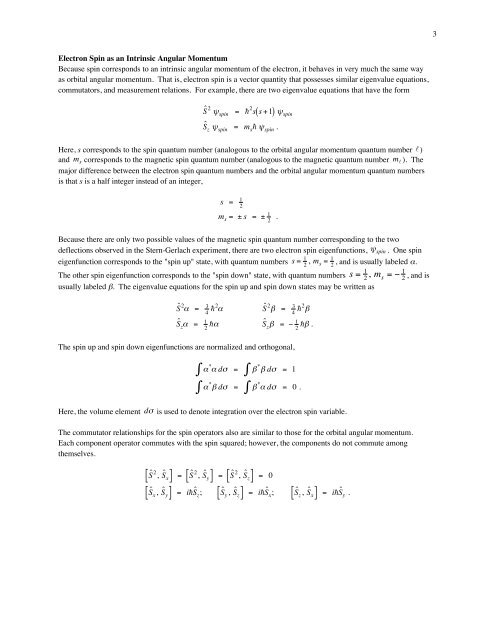Electron Spin
Electron Spin
Electron Spin
You also want an ePaper? Increase the reach of your titles
YUMPU automatically turns print PDFs into web optimized ePapers that Google loves.
3<strong>Electron</strong> <strong>Spin</strong> as an Intrinsic Angular MomentumBecause spin corresponds to an intrinsic angular momentum of the electron, it behaves in very much the same wayas orbital angular momentum. That is, electron spin is a vector quantity that possesses similar eigenvalue equations,commutators, and measurement relations. For example, there are two eigenvalue equations that have the formˆ S 2 ψ spin = 2 s s +1 ( ) ψ spinˆ S z ψ spin = m s ψ spin .€Here, s corresponds to the spin quantum number (analogous to the orbital angular momentum quantum number )and m s corresponds to the magnetic€spin quantum number (analogous to the magnetic quantum number m ). Themajor difference between the electron spin quantum numbers and the orbital angular momentum quantum numbersis that s is a half integer instead of an integer,€€s = 1 2m s = ± s = ± 1 2 .Because there are only two possible values of the magnetic spin quantum number corresponding to the twodeflections observed in the Stern-Gerlach € experiment, there are two electron spin eigenfunctions, ψ spin . One spineigenfunction corresponds to the "spin up" state, with quantum numbers s = 1 , m 2 s = 1 2, and is usually labeled α.The other spin eigenfunction corresponds to the "spin down" state, with quantum numbers s = 1 2 , m s = − 1 2 , and isusually labeled β. The eigenvalue equations for the spin up and spin down states may be € written as€S ˆ 2 α = 3 4 2 α S ˆ 2 β = 3 4 2 βˆ€S z α = 1 2 αS ˆz β = − 1 2 β .The spin up and spin down eigenfunctions are normalized and orthogonal,€∫ α * α dσ = ∫ β * β dσ = 1∫ α * β dσ = ∫ β * α dσ = 0 .Here, the volume element dσ is used to denote integration over the electron spin variable.€The commutator relationships for the spin operators also are similar to those for the orbital angular momentum.Each component € operator commutes with the spin squared; however, the components do not commute amongthemselves.S ˆ[ 2 , S ˆx ] = S ˆ[ 2 , S ˆy ] = ˆS ˆ[ , S ˆx y ] = iS ˆz ; S z[ S 2 , S ˆz ] = 0S ˆ , ˆ S y x ;[ ] = i ˆS ˆ[ , S ˆz x ] = iS ˆy .€
















